Three stage forehead folded flap
1. Introduction
Single subunit defects (tip or ala) that require only modest skin resurfacing and limited cartilage replacement can be resurfaced with forehead skin transferred in two stages.
However, when a forehead flap in transferred in only two stages, it is not possible to alter the inferior nose, columella, or ala at the time of pedicle transfer without devascularization.
Large deep defects which encompass multiple nasal units or require extensive replacement of cartilage support or nasal lining should be reconstructed with a full thickness forehead flap in three stages.
Unilateral or bilateral full thickness defects of the distal nose up to 2 – 2.5 cm in height can be lined by folding the distal end of a forehead flap. This permits a forehead flap to both provide external skin cover and internal lining.
More details on nasal lining can be found here.
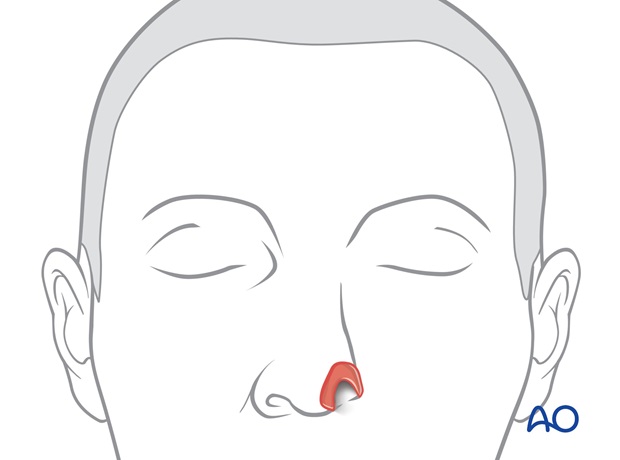
The forehead is thicker than nasal skin and excessive subcutaneous fat and frontalis muscle must be excised to create a skin flap of a thickness similar to that of the missing skin of the nose. Although the excessive soft tissue can be excised at the time of harvest, in larger more complicated defects it is safer to thin the excess during an intermediate operation prior to pedicle division.
This improves vascular safety and aesthetic results. The intermediate operation allows the surgeon to re-elevate the flap completely and aesthetically contour the inferior nose by soft tissue excision and cartilage modification.
The advantages of a full thickness three stage flap are:
- Maximum vascularity at the time of transfer and at the intermediate second stage operation.
- The ability to create a uniformly thin supple skin flap.
- Staged soft tissue sculpture, primary and delayed primary cartilage grafting.
- The ability to correct previous intraoperative errors of judgments or imperfections of healing prior to pedicle division.
- Modified techniques to provide vascular lining as a folded distal flap extension or as a skin graft.
Principles of reconstruction
Each defect is different but each reconstruction is simplified because the "Normal" never changes so the principles of repair remain the same. The contralateral normal remains as a visible comparison. If the contralateral normal is unavailable, the ideal is used as a guide.
The face can be described in regional units characterized by:
- Skin quality
- Border outline
- 3 dimensional contour
The principles of nasal reconstruction which apply to large deep defect which will be resurfaced with a flap are:
- Recreate nasal subunits, not just fill the defect.
- Alter the wound in site, size and depth to improve the final result
- If appropriate, excise residual normal skin within the subunit to replace missing skin as a unit, rather than as a patch (subunit principle)
- Use the contralateral Normal or the Ideal as a guide
- Replace missing tissues exactly
- Employ surgical templates
- Build on a stable platform
Subunit principle: If a defect encompasses more than 50 % of a convex subunit – tip or ala - remaining normal skin is excised within the subunit and the entire subunit is resurfaced with a subunit flap. This positions final border scars in the junctions between adjacent subunits and harnesses flap trapdoor contraction and postoperative pin cushioning, and in combination with shaped underlying cartilage support, augments the shape of underlying cartilage support over the entire subunit.
Anaesthesia
This procedure is performed under general anaesthesia to minimize soft tissue distortion and vasoconstriction associated with local anaesthetic injection.
The fluid volume of local anaesthetic alters the dimension, thickness, and position of both the donor tissues and recipient site. The blanching caused by epinephrine will make intraoperative evaluation of tissue vascularity difficult.
2. Resection
If an initial excision is required to treat skin cancer, the tumor is excised utilizing standard excisional margins, verified by frozen section by the operating surgeon or the operating Mohs surgeon.
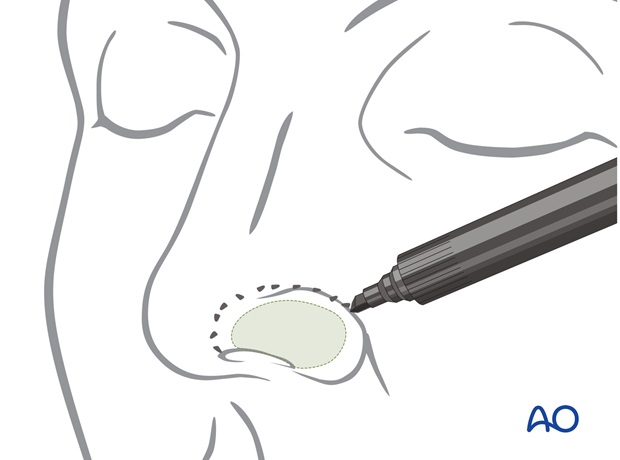
3. Stage 1: Flap template
The subunits of the nose and regional units of the face are marked with ink.
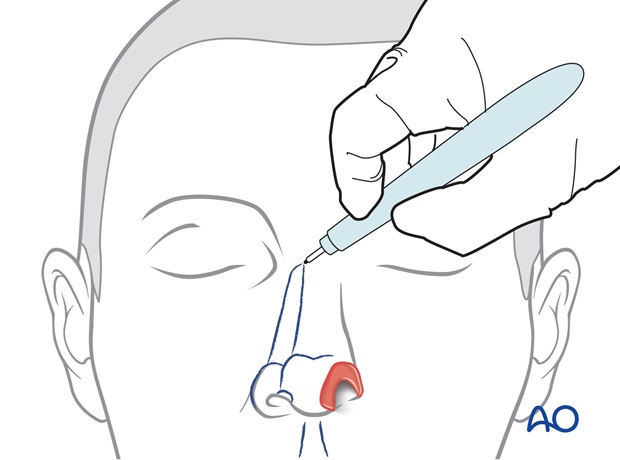
If intact prior to skin cancer incision, a template of the nasal subunits requiring resurfacing is created using quarter inch adhesive paper tape and collodion.
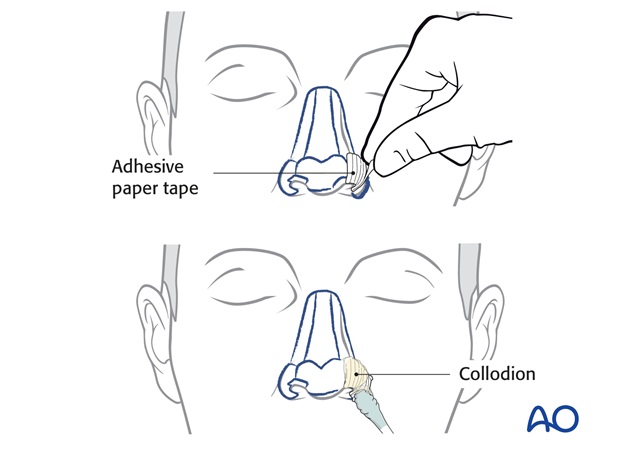
If significant parts of the nose remain, a template can be made of the remaining contralateral normal nose.
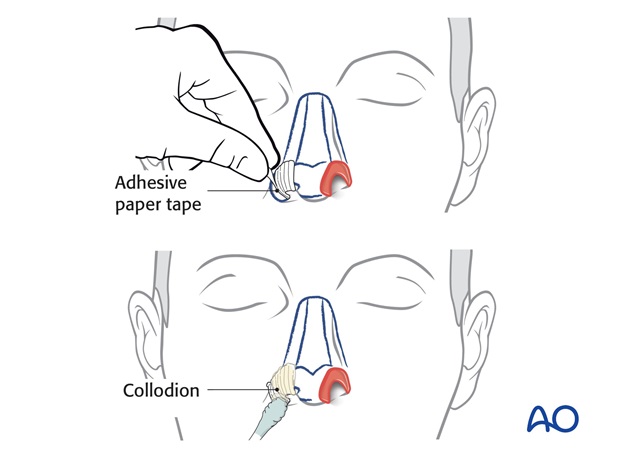
A second pattern is made of the lining defect.

Excision of residual skin
If a subunit excision is planned, residual normal skin within the subunits is excised.
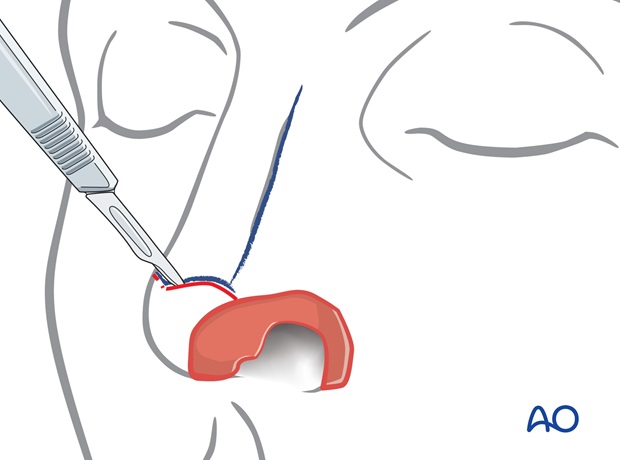
4. Stage 1: Reconstruction of cartilage support
The cartilaginous and bony framework of the nose is enveloped by the external covering skin and internal lining. This framework supports and shapes soft tissues and braces a reconstructed nose against gravity, tension, and scar contraction. If missing, nasal support must be replaced. The dimension, border outline, and shape of these bone and cartilage support grafts will re-establish the normal nasal contour.
Primary cartilage support grafts are placed as necessary in all areas where the underlying, normal residual nasal lining remains intact. But, normally no cartilage is placed in the area of forehead flap folding because it is difficult to position, fix, and design grafts in that area.
The choice of donor material will depend on the needs of the defect:
- Graft size
- Graft shape
- Graft rigidity
Septal cartilage is straight but of limited length and thickness.
Ear cartilage is relatively soft, curved, but limited in availability.
Rib cartilage is available in large quantity, thickness, has rigidity, and can be shaved into thinner more bendable strips with suture material.
Grafts are fixed with sutures to remaining nasal support structures and fixed to one another to recreate a rigid nasal framework to support and shape the nose.
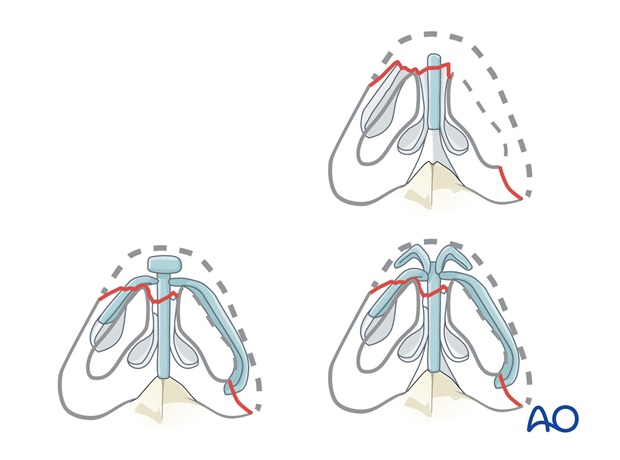
Tip reconstruction
The volume, dimension, and contour of the tip subunit depend on the underlying cartilage framework.
Parts or all of the normal tip support may be missing. Each component must be reconstructed to support, shape and brace the reconstructed tip postoperatively
Septal, ear, or rib cartilage is used to reconstruct the tip complex to replace the missing medial and lateral crura as needed.

If the underlying tip cartilage is intact, it is useful to improve tip support by fixing a columella strut between the intact medial crura.
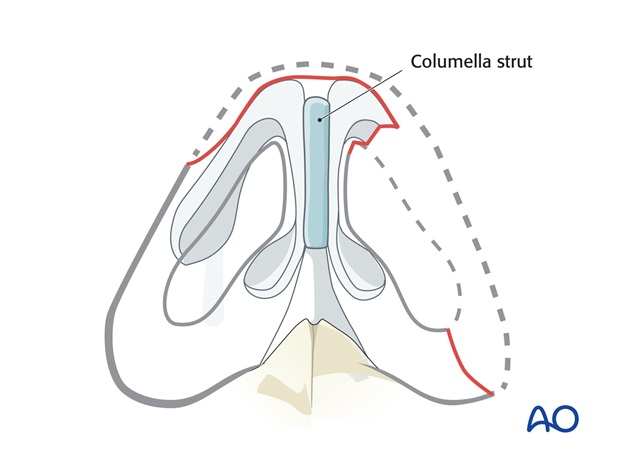
If the domes and anterior medial crura are missing, a columella strut is fixed between the remaining medial crura to restore central support.
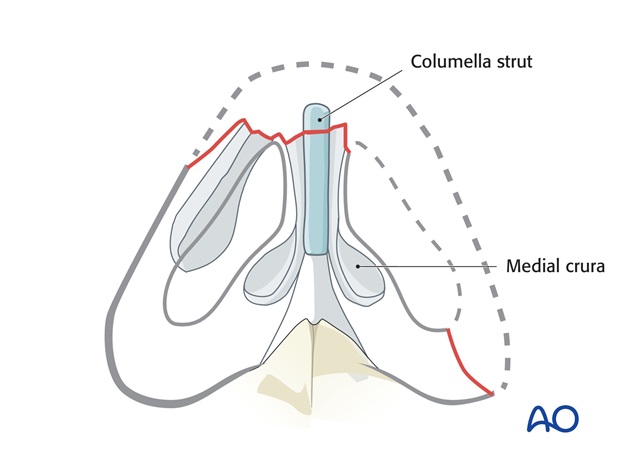
If the tissue injury is larger, a longer columella graft can be placed and fixed to the nasal spine with a suture.
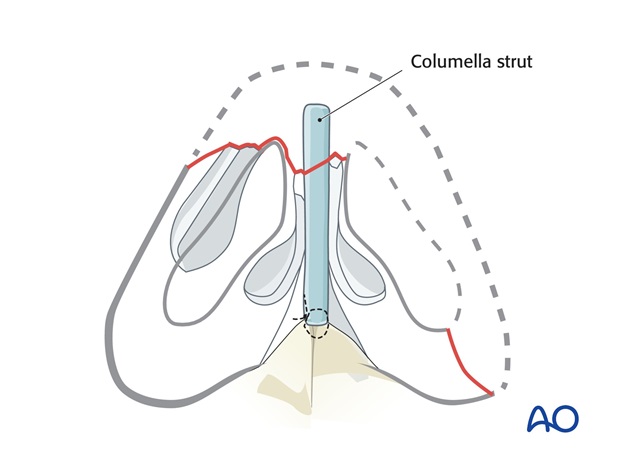
The lateral crura which give tip volume, projection and contour are rebuilt with a Peck graft, often combined with alar margin rim grafts to support the soft triangles.
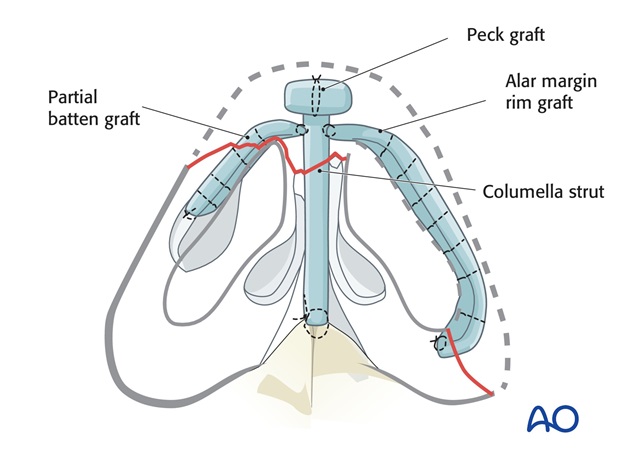
Alternatively, the tip can be rebuilt with anatomically shaped tip grafts – middle and lateral crura replacements of ear or rib cartilage that are bent with sutures to mimic the normal anatomy.
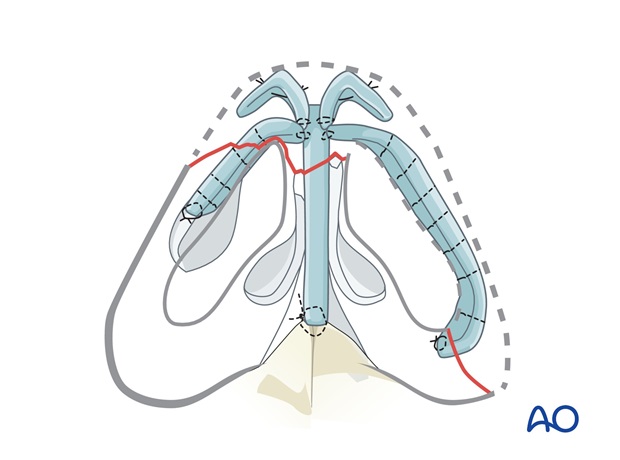
5. Stage 1: Transfer of a paramedian forehead flap
Outline of paramedian forehead flap
The templates are positioned under the hairline directly superiorly to its supratrochlear pedicle, which is located a few mm lateral to the frown crease (verified by doppler).
The lining template is oriented as a distal skin extension of the cover flap, carefully positioning it along the proposed nostril margin in the area of the lining deficiency. If lining is missing along both nostril margins, lining extensions are designed bilaterally.
The outline and the dimension of the flap will be designed to resurface parts or all of the dorsum, tip, and ala depending on the defect.
The paramedian flap is perfused by the supratrochlear vessels and can be based on either side of the forehead. Unilateral defects are more easily resurfaced with the ipsilateral flap because its pedicle is closer to the defect.
Either the right or left pedicle can be chosen for midline defects.

The lining pattern must be carefully marked so that when the distal forehead flap is folded into the lining defect, the skin for lining will be correctly oriented.
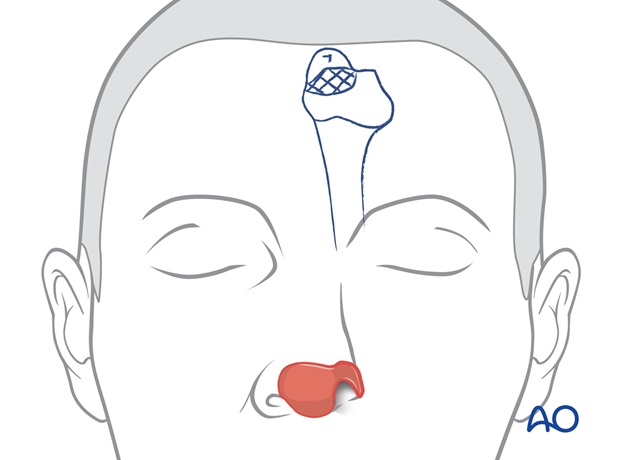
Centered over the supratrochlear vessels, the flap's pedicle is drawn inferiorly through the medial eyebrow, narrowing to 1.2 to 1.5 cm in width at the pedicle base.
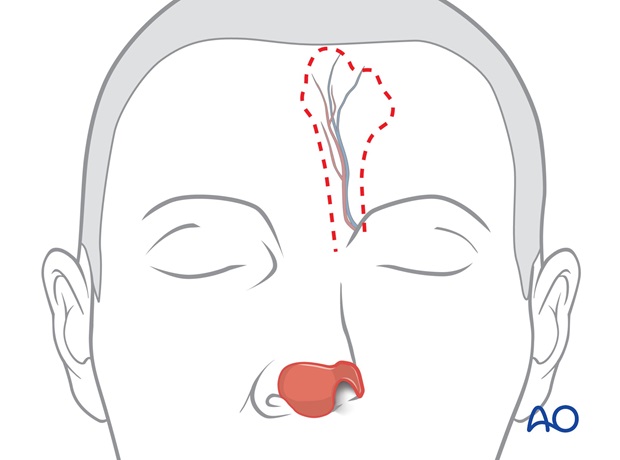
The border of the flap is incised, elevating the flap from distal to proximal over the periosteum to its pedicle base, with the underlying tissues and frontalis muscle, as a full thickness flap without thinning.
This maintains the skin vascularity through the deep dermis, frontalis muscle and axial supratrochlear vessels.
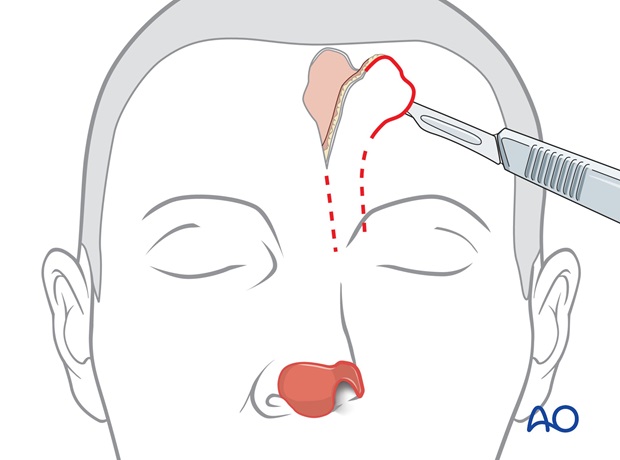
The flaps base is incised through the medial eyebrow separating the corrugator muscle until it can be rotated medially to cover the nasal defect without tension.
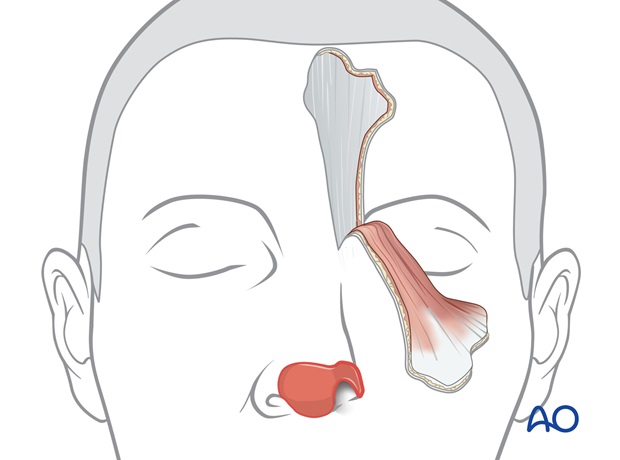
Closure of donor site defect
A scalp dog ear is excised and the forehead is widely undermined.
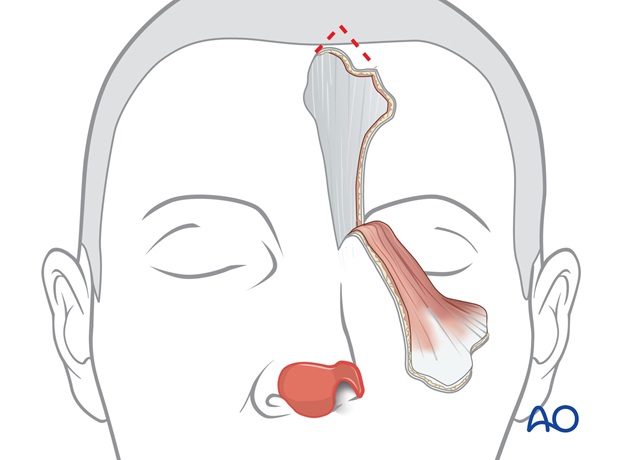
The forehead defect is closed in layers.
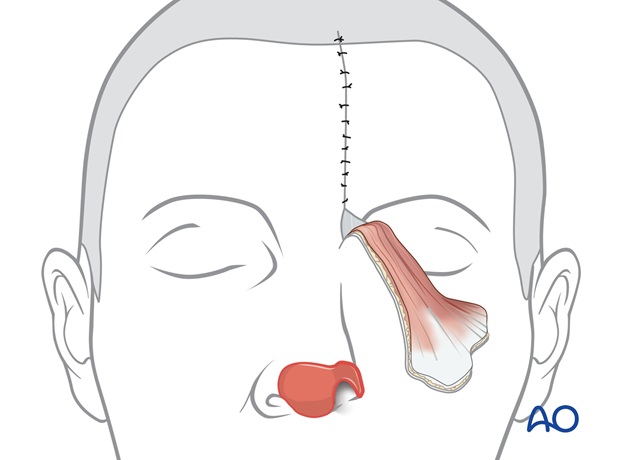
If the superior aspect of the defect cannot be closed primarily, it is allowed to heal secondarily over several weeks. The open area is covered with a petrolatum gauze for one week.
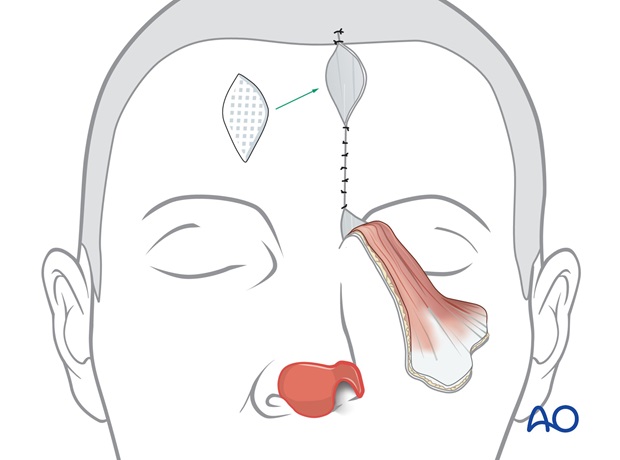
Flap inset
The distal end of the forehead flap is folded inwards into the nose. Normally the flap is not thinned of excess subcutaneous fat or frontalis muscle, but if the flap is especially stiff, the deep soft tissues can be thinned in the area of lining.
The blood supply of a full thickness forehead flap is abundant and the flap tolerates folding without ischemic problems.
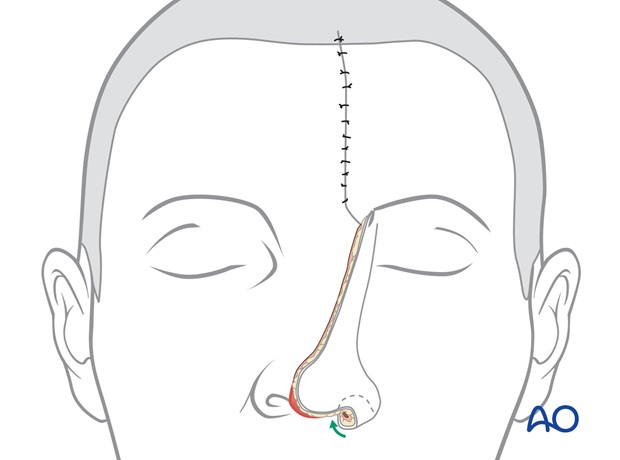
The lining extension is sutured into the lining defect and the external skin sutured along the periphery of the skin loss.
If missing, central tip support is replaced at the time of flap transfer with a columellar strut and a tip graft over vascularized intact lining.
Normally, alar battens are not placed primarily to support the alar margin due to the awkwardness of positioning rim grafts within the folded extent of the forehead flap. An alar batten is placed secondarily during the second stage intermediate operation.
A skin graft is placed on the deep raw surface of the pedicle to limit postoperative oozing.
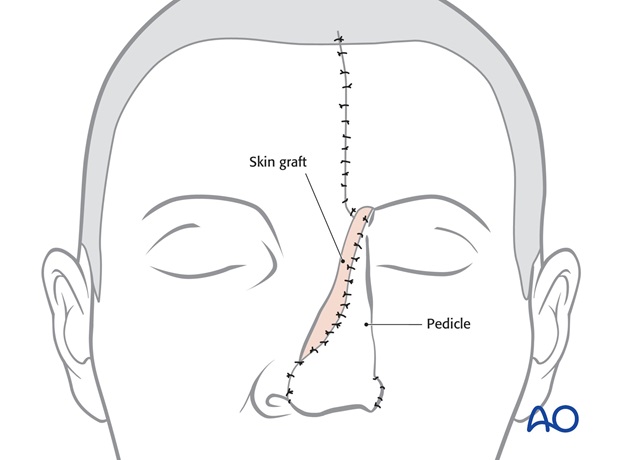
6. Stage 2: Thinning of the flap
One month later the bulky flap has healed to the recipient site.
The distal lining end of the forehead flap is now healed to the adjacent normal lining and is no longer dependent of the forehead flap blood supply to survive.
Because of its prior elevation and rotation it is effectively physiologically delayed, augmenting its blood supply.
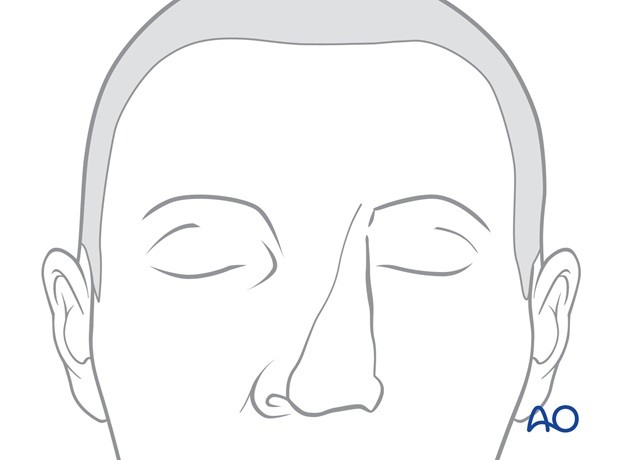
The borders of the flap and the ideal nostril margin are marked and the ideal nostil margin is incised separating the cover flap from the lining flap.
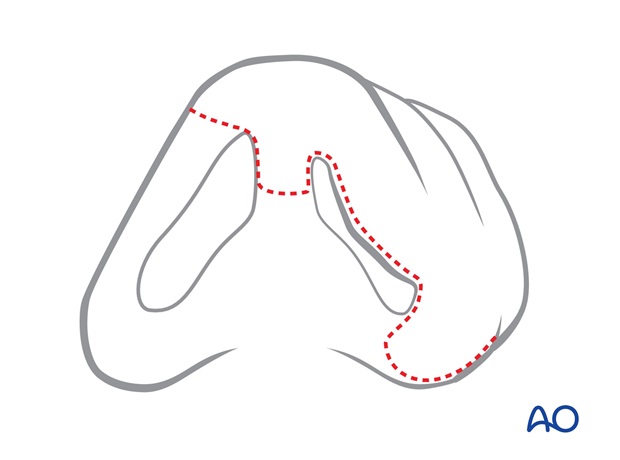
The skin of the covering flap is then elevated with 2-3 mm of subcutaneous fat and completely removed from the recipient site.
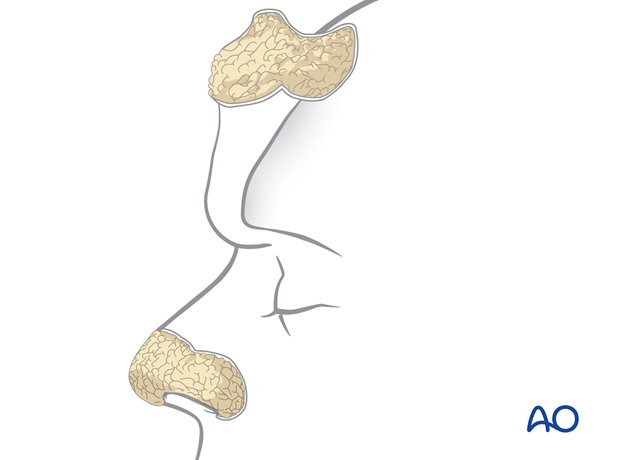
This exposes the underlying "doubled layer" of subcutaneous fat and frontalis muscle.
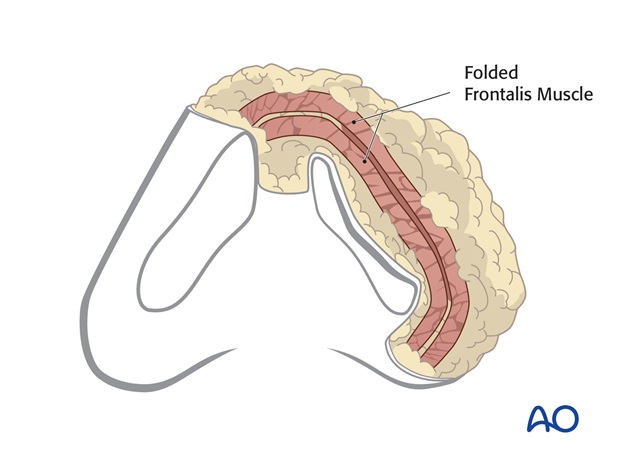
This excess soft tissue is excised leaving only the reconstructed lining and residual folded frontalis muscle and subcutaneous fat. This excess is excised to expose thin healed alar lining
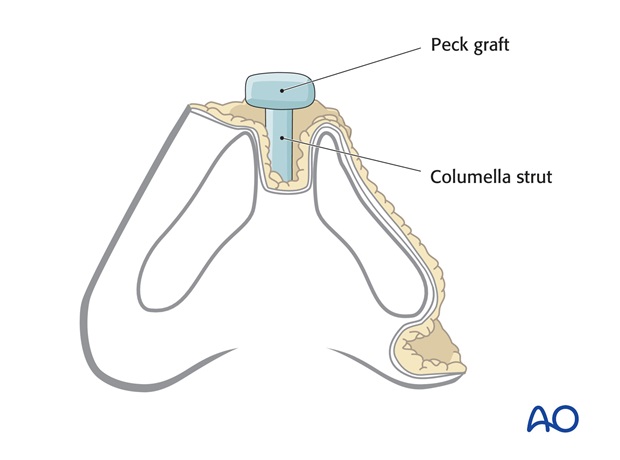
Alar reconstruction
Normally the ala contains no cartilage, but an alar rim is now supported with a delayed primary alar batten support graft to support, shape and brace the reconstructed ala postoperatively. The graft is fixed to the prior tip repair.
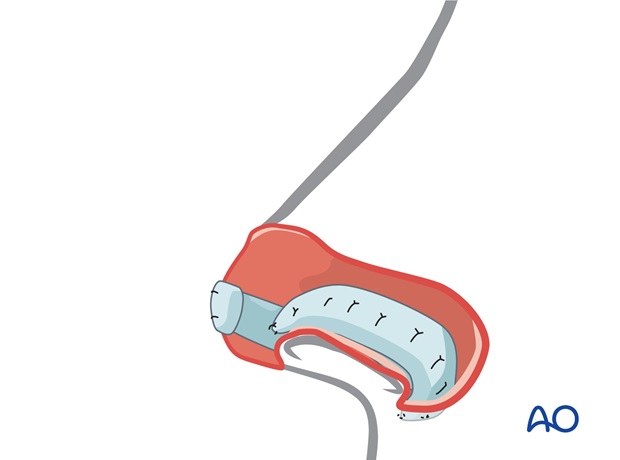
The conchal cartilage is harvested through a postauricular incision.
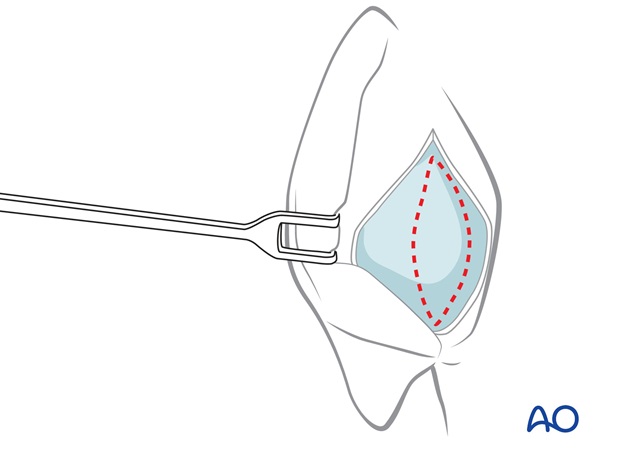
The alar template is used as a guide to create a nostril margin graft of the correct dimension and border outline.
Same problem with poor shape to the nostril margin
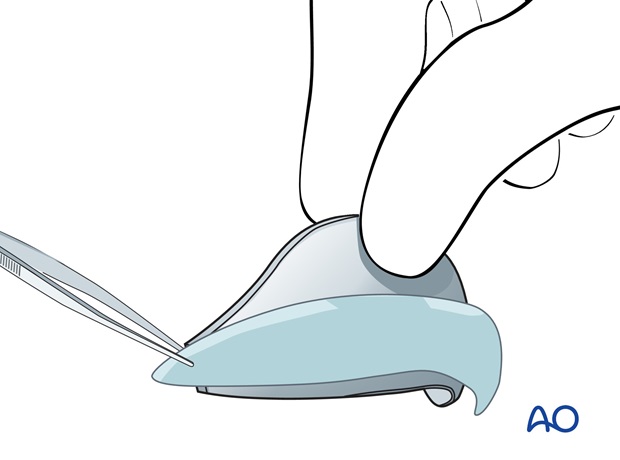
The dimension of the graft is extended a few mm medially and laterally to allow its fixation in small subcutaneous pockets created laterally within the soft tissues of the alar base and medially under the skin of the tip if intact or to reconstructed tip support.
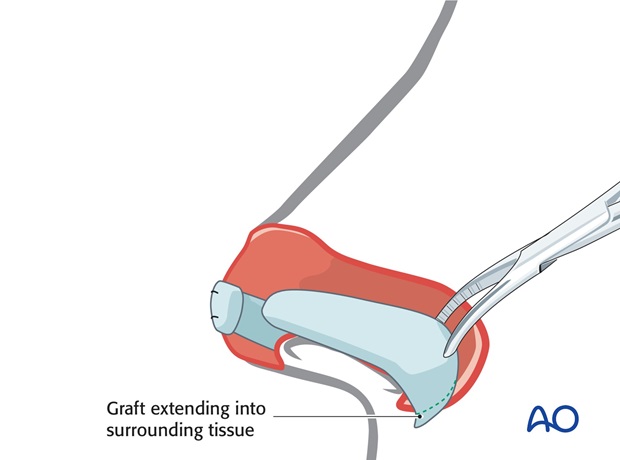
The ear cartilage graft is guided and fixed into the pockets with percutaneous quilting sutures medially and laterally and the graft itself is sutured to the underlying raw lining surface.
Other areas of excess soft tissue are debulked and old primary cartilage grafts, placed during the first stage, are modified as necessary.
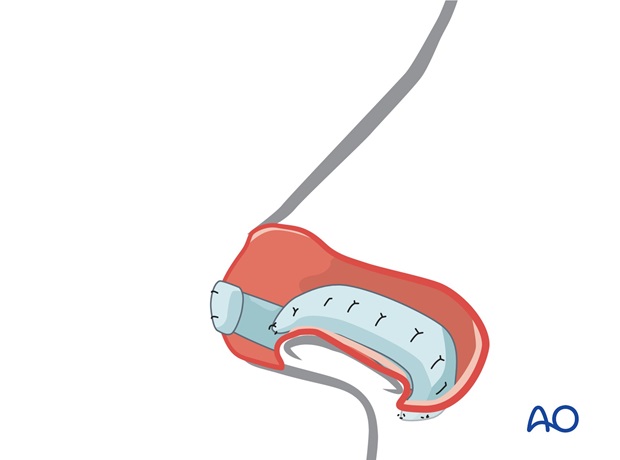
The thin skin flap is returned to the recipient site fixing its cutaneous surface to the underlying bed using percutaneous quilting sutures and its peripheral borders with single layer skin sutures.
The skin quilting sutures are removed in 24 hours and the skin sutures in 5-7 days.
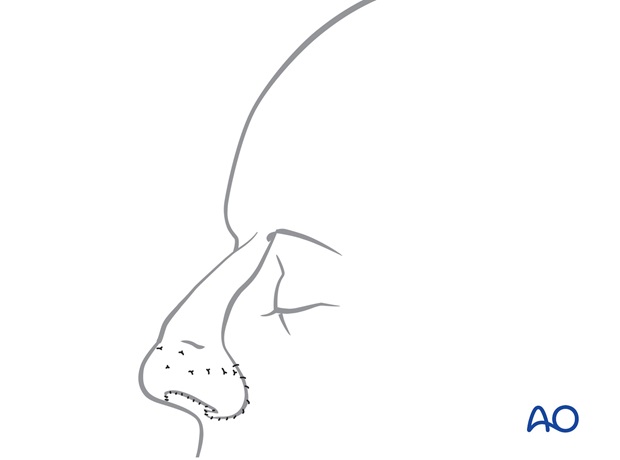
7. Stage 3: Pedicle division
The regional units of the nose are marked with ink.
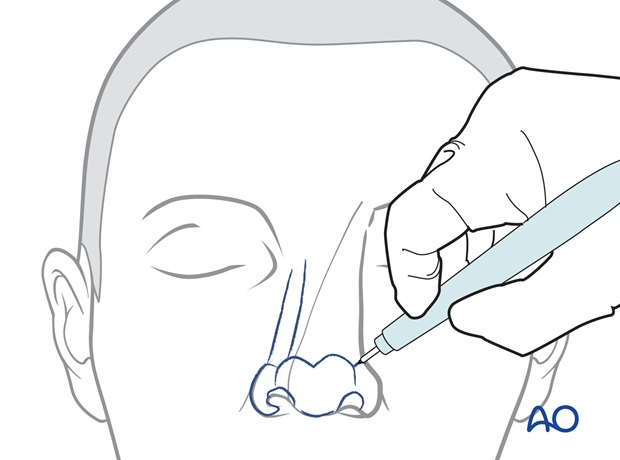
The site of pedicle division is marked, leaving excess tissue that can be trimmed at the time of fine tuning the reconstructed subunit.
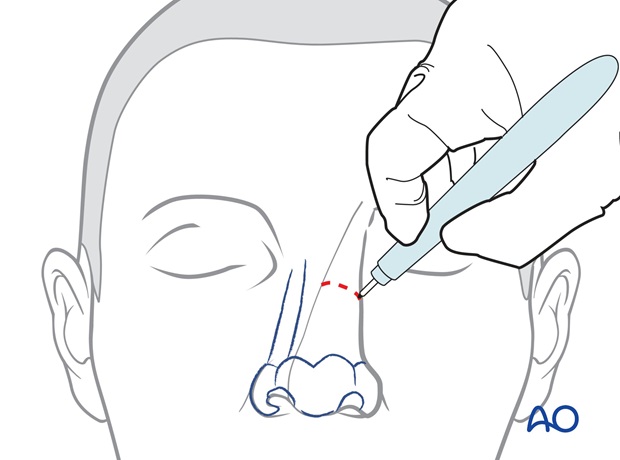
The pedicle is divided. The skin of the nasal inset is elevated with 2-3 mm of subcutaneous fat over the superior aspect of the reconstructed nose.
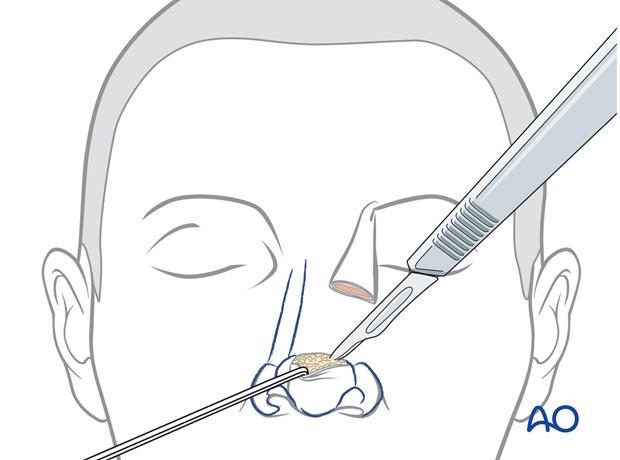
Trimming
A forehead flap can be extensively re-elevated towards the nostril margin and the columella inset. Because the operation is performed under general anaesthesia without local anaesthesia, the flaps colour and capillary refill can be evaluated.
Underlying subcutaneous fat or excess cartilage over the superior nose is excised to sculpt the sidewall and dorsal contour as well as deepen the alar crease.
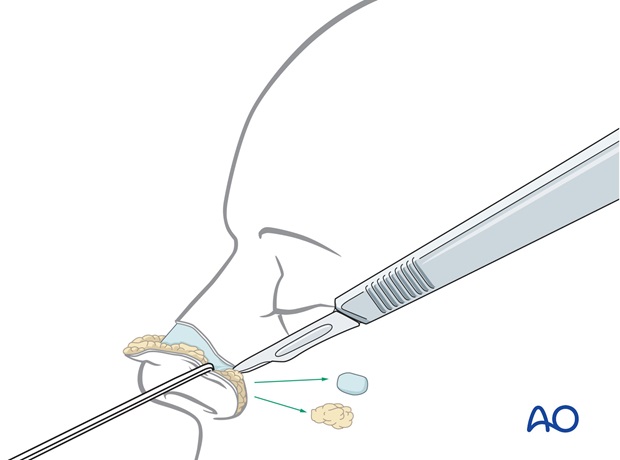
Excess forehead skin is trimmed and the forehead skin inset with percutaneous quilting sutures and a single layer skin closure.
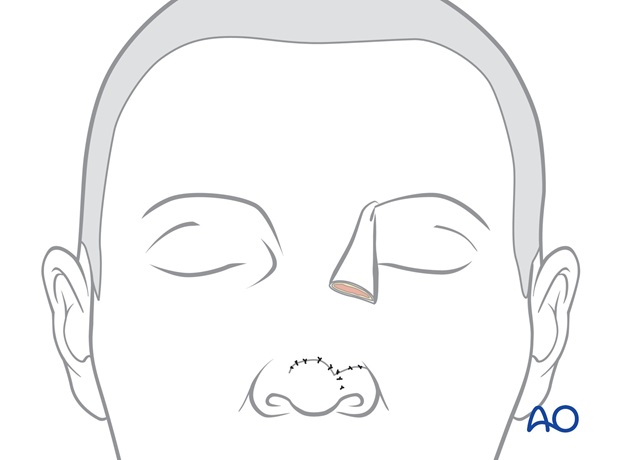
Forehead closure
The inferior part of the forehead scar through the medial eyebrow is reopened.
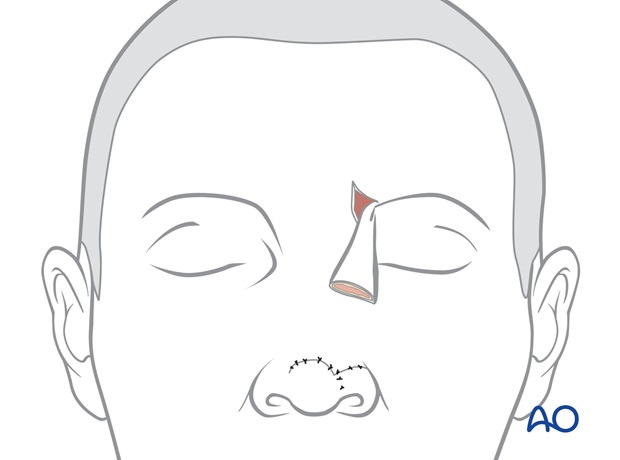
The skin of the proximal forehead pedicle is elevated with several mm of subcutaneous fat from the underlying excess soft tissue and previous skin graft of the proximal pedicle. The excess underlying soft tissue bulk is excised.
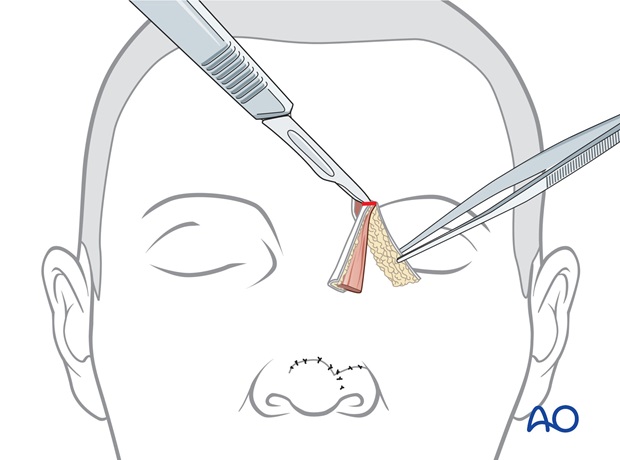
The skin of the proximal pedicle is trimmed, returning the medial eyebrow to its normal position and inset as a small inverted V whose scars simulate the normal frown crease.
It is fixed in place with a temporary quilting suture and a layered skin closure.
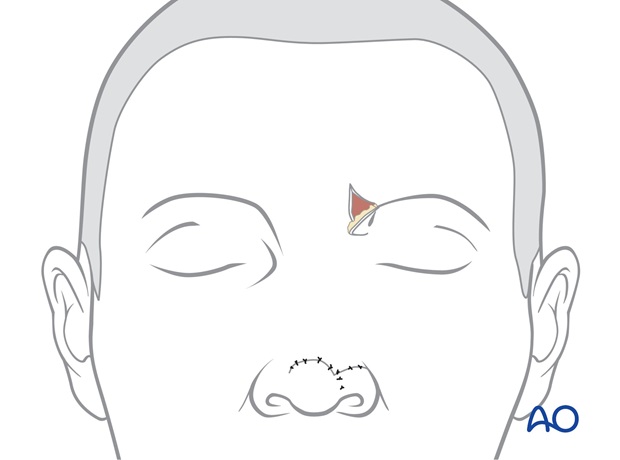
Revision surgery
Almost all major nasal reconstruction will require a revision procedure four months after the initial reconstruction to improve the final result.
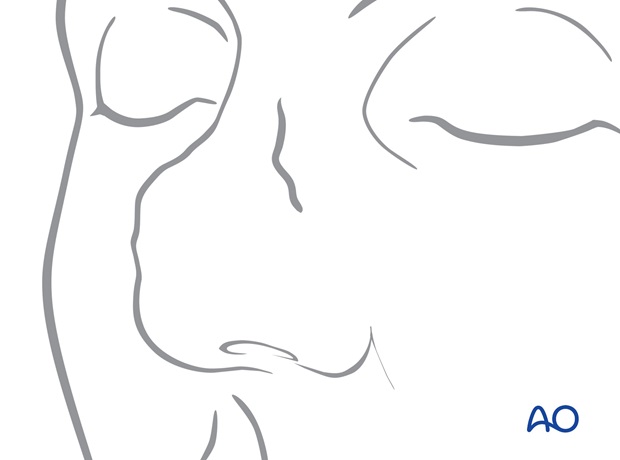
Cases
Pre-and postoperative photographs of a small full thickness defect repaired with a three stage forehead folded flap.
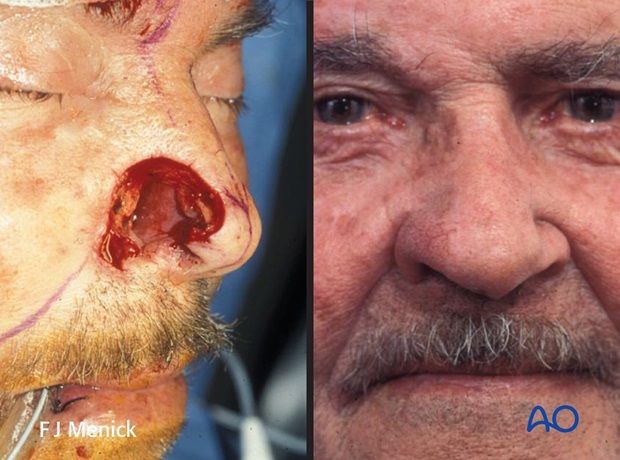
Pre-and postoperative photographs of a full-thickness defect repaired with a 3 stage forehead flap, cartilage grafts, and ipsilateral and contralateral septal intranasal lining flaps.
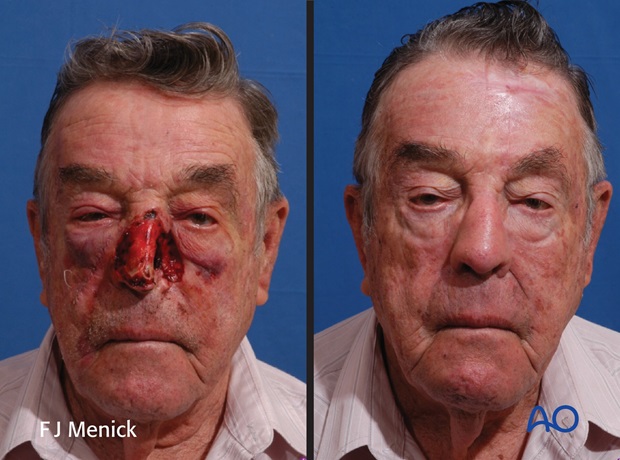
Pre-and postoperative photograph of a subtotal nasal defect repaired with a 3 stage forehead flap, rib cartilage grafts and composite septal flap lining.
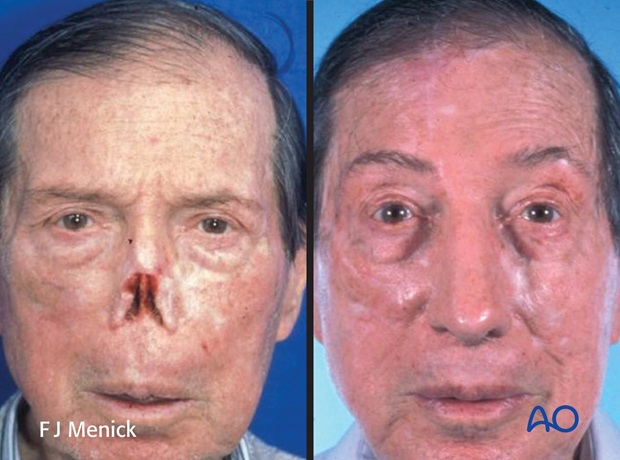
Pre-and postoperative photograph of a full-thickness nasal defect repaired with a 3 stage forehead flap and ipsilateral and contralateral intranasal lining flaps.
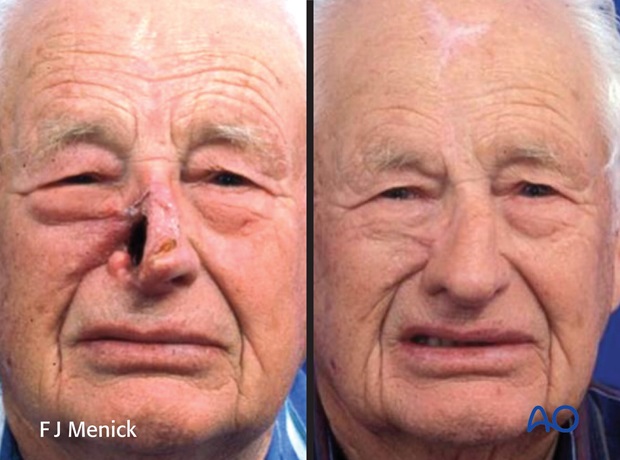
8. Aftercare following nose reconstruction
Skin graft
The bolus skin graft dressing should be kept dry. The forehead donor site can be washed within 24 h.
Forehead nasal reconstructions
Routine showering is permitted within 24 hours of all surgical sites. Dressings are worn at the discretion of the patient.
Quilting sutures are removed after 48h. Routine skin sutures are removed after 7 days. Sun exposure is avoided for several months after surgery.













